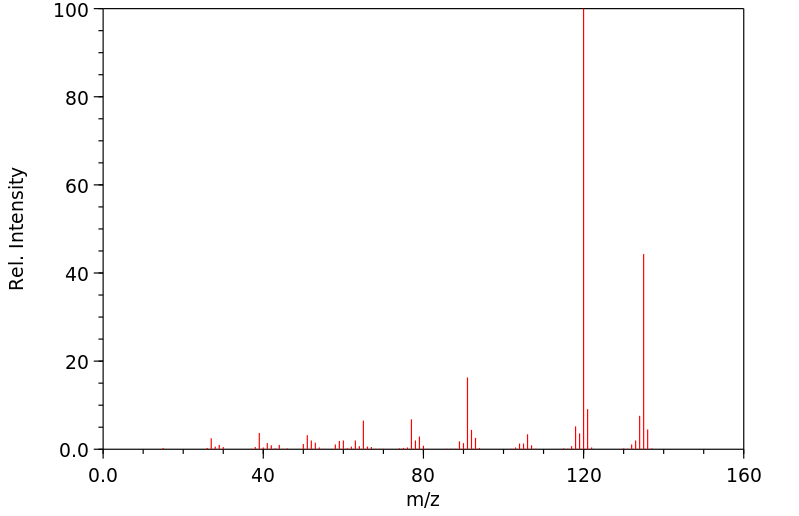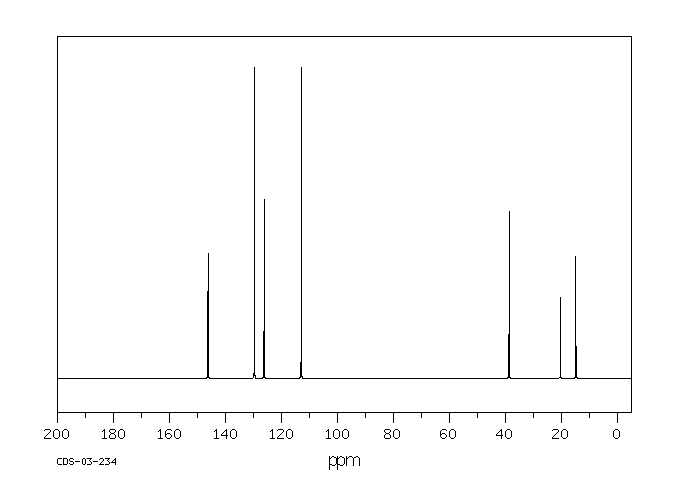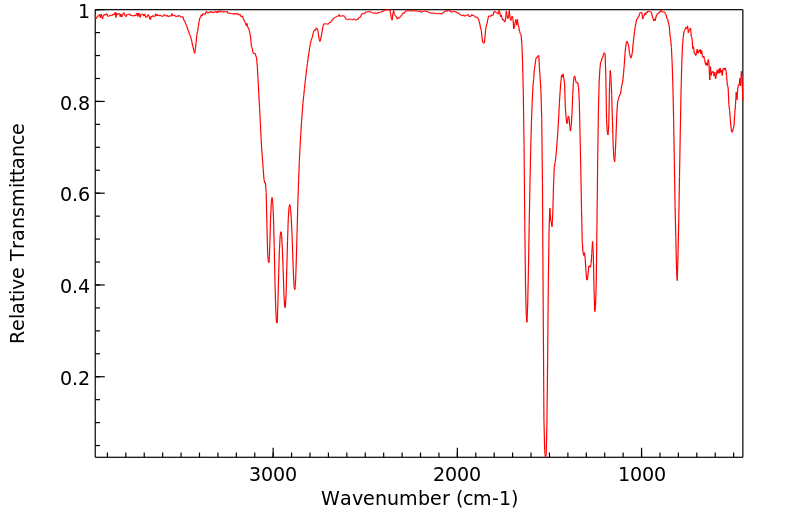N-乙基对甲苯胺 | 622-57-1
中文名称
N-乙基对甲苯胺
中文别名
1-乙基氨基-4-甲基苯;N-乙基-4-甲基苯胺;4-乙氨基甲苯;N-乙基对甲基苯胺;乙氨基对甲苯;4-(乙氨基)甲苯
英文名称
N-ethyl-p-tolylamine
英文别名
N-ethyl-4-methylaniline;N-ethyl-p-toluidine
CAS
622-57-1
化学式
C9H13N
mdl
MFCD00035793
分子量
135.209
InChiKey
AASABFUMCBTXRL-UHFFFAOYSA-N
BEILSTEIN
——
EINECS
——
-
物化性质
-
计算性质
-
ADMET
-
安全信息
-
SDS
-
制备方法与用途
-
上下游信息
-
文献信息
-
表征谱图
-
同类化合物
-
相关功能分类
-
相关结构分类
物化性质
-
熔点:-6.87°C (estimate)
-
沸点:222 °C
-
密度:0,94 g/cm3
-
闪点:93°C
-
溶解度:溶于乙醇、乙醚
-
物理描述:N-ethyl-p-toluidine appears as a dark colored liquid with an aromatic odor. Insoluble in water and about the same density as water. Toxic by skin absorption and inhalation of vapors. Toxic fumes may evolve during combustion.
-
保留指数:1276.4;1276.4;1277.3
计算性质
-
辛醇/水分配系数(LogP):2.5
-
重原子数:10
-
可旋转键数:2
-
环数:1.0
-
sp3杂化的碳原子比例:0.333
-
拓扑面积:12
-
氢给体数:1
-
氢受体数:1
安全信息
-
危险等级:6.1
-
安全说明:S23,S36/37/39
-
危险类别码:R20/21/22
-
危险品运输编号:2754
-
储存条件:应存放在室温、干燥且充满惰性气体的环境中。
SDS
N-乙基对甲苯胺 修改号码:4
模块 1. 化学品
产品名称: N-Ethyl-p-toluidine
修改号码: 4
模块 2. 危险性概述
GHS分类
物理性危害
易燃液体 第4级
健康危害
急性毒性(经口) 第2级
急性毒性(经皮) 第2级
急性毒性(吸入) 第2级
皮肤腐蚀/刺激 第2级
严重损伤/刺激眼睛 2A类
环境危害
急性水生毒性 第3级
慢性水生毒性 第3级
GHS标签元素
图标或危害标志
信号词 危险
危险描述 可燃液体
吸入或皮肤接触或吞咽致命。
造成皮肤刺激
造成严重眼刺激
对水生生物有害
长期影响对水生生物有害
防范说明
N-乙基对甲苯胺 修改号码:4
模块 2. 危险性概述
[预防] 远离明火/热表面。
切勿吸入。
切勿碰到眼睛,皮肤或衣服。
只能在室外或通风良好的环境下使用。
避免释放到环境中。
使用本产品时切勿吃东西,喝水或吸烟。
处理后要彻底清洗双手。
佩戴防护面具。
穿戴防护手套/护目镜/防护面具。
[急救措施] 吸入:将受害者移到新鲜空气处,在呼吸舒适的地方保持休息。立即呼叫解毒中心/医
生。
食入:立即呼叫解毒中心/医生。
眼睛接触:用水小心清洗几分钟。如果方便,易操作,摘除隐形眼镜。继续冲洗。
眼睛接触:求医/就诊
皮肤接触:用大量肥皂和水轻轻洗。
若皮肤刺激:求医/就诊。
立即去除/脱掉所有被污染的衣物。
被污染的衣物清洗后方可重新使用。
立即呼叫解毒中心/医生。
[储存] 存放于通风良好处。保持容器密闭。
存放处须加锁。
[废弃处置] 根据当地政府规定把物品/容器交与工业废弃处理机构。
模块 3. 成分/组成信息
单一物质/混和物 单一物质
化学名(中文名): N-乙基对甲苯胺
百分比: >98.0%(GC)(T)
CAS编码: 622-57-1
俗名: N-Ethyl-4-methylaniline , 4-(Ethylamino)toluene
分子式: C9H13N
模块 4. 急救措施
吸入: 将受害者移到新鲜空气处,保持呼吸通畅,休息。立即呼叫解毒中心/医生。
皮肤接触: 立即去除/脱掉所有被污染的衣物。用大量肥皂和水轻轻洗。
立即呼叫解毒中心/医生。
眼睛接触: 用水小心清洗几分钟。如果方便,易操作,摘除隐形眼镜。继续清洗。
立即呼叫解毒中心/医生。
食入: 立即呼叫解毒中心/医生。漱口。
紧急救助者的防护: 救援者需要穿戴个人防护用品,比如橡胶手套和气密性护目镜。
模块 5. 消防措施
合适的灭火剂: 干粉,泡沫,二氧化碳
不适用的灭火剂: 水(有可能扩大灾情。)
特殊危险性: 小心,燃烧或高温下可能分解产生毒烟。
特定方法: 从上风处灭火,根据周围环境选择合适的灭火方法。
非相关人员应该撤离至安全地方。
周围一旦着火:如果安全,移去可移动容器。
消防员的特殊防护用具: 灭火时,一定要穿戴个人防护用品。
N-乙基对甲苯胺 修改号码:4
模块 6. 泄漏应急处理
个人防护措施,防护用具, 使用特殊的个人防护用品(自携式呼吸器)。远离溢出物/泄露处并处在上风处。确保
紧急措施: 足够通风。
泄露区应该用安全带等圈起来,控制非相关人员进入。
环保措施: 防止进入下水道。
控制和清洗的方法和材料: 用合适的吸收剂(如:旧布,干砂,土,锯屑)吸收泄漏物。一旦大量泄漏,筑堤控
制。附着物或收集物应该立即根据合适的法律法规废弃处置。
副危险性的防护措施 移除所有火源。一旦发生火灾应该准备灭火器。使用防火花工具和防爆设备。
模块 7. 操作处置与储存
处理
技术措施: 在通风良好处进行处理。穿戴合适的防护用具。防止烟雾产生。远离明火和热表面。
采取措施防止静电积累。使用防爆设备。处理后彻底清洗双手和脸。
注意事项: 使用封闭系统,通风。
操作处置注意事项: 避免接触皮肤、眼睛和衣物。
贮存
储存条件: 保持容器密闭。存放于凉爽、阴暗、通风良好处。
存放于惰性气体环境中。
存放处须加锁。
远离不相容的材料比如氧化剂存放。
气敏
包装材料: 依据法律。
模块 8. 接触控制和个体防护
工程控制: 尽可能安装封闭体系或局部排风系统。同时安装淋浴器和洗眼器。
个人防护用品
呼吸系统防护: 半面罩或全面罩呼吸器,自携式呼吸器(SCBA),供气呼吸器等。依据当地和政府法
规,使用通过政府标准的呼吸器。
手部防护: 防渗手套。
眼睛防护: 护目镜。如果情况需要,佩戴面具。
皮肤和身体防护: 防渗防护服。如果情况需要,穿戴防护靴。
模块 9. 理化特性
外形(20°C): 液体
外观: 透明
颜色: 极淡的黄色-黄色
气味: 无资料
pH: 无数据资料
熔点: 无资料
沸点/沸程 222 °C
闪点: 89°C
爆炸特性
爆炸下限: 无资料
爆炸上限: 无资料
密度: 0.94
溶解度: 溶于: 醚 酒精
模块 10. 稳定性和反应性
化学稳定性: 一般情况下稳定。
危险反应的可能性: 未报道特殊反应性。
避免接触的条件: 明火
N-乙基对甲苯胺 修改号码:4
模块 10. 稳定性和反应性
须避免接触的物质 氧化剂
危险的分解产物: 一氧化碳, 二氧化碳, 氮氧化物 (NOx)
模块 11. 毒理学信息
急性毒性: 无资料
对皮肤腐蚀或刺激: 无资料
对眼睛严重损害或刺激: 无资料
生殖细胞变异原性: 无资料
致癌性:
IARC = 无资料
NTP = 无资料
生殖毒性: 无资料
模块 12. 生态学信息
生态毒性:
鱼类: 无资料
甲壳类: 无资料
藻类: 无资料
残留性 / 降解性: 2% (by BOD)
潜在生物累积 (BCF): <0.2 - 4.1 (conc. 0.2 mg/L), <2.2 (conc. 0.02 mg/L)
土壤中移动性
log水分配系数: 无资料
土壤吸收系数 (Koc): 无资料
亨利定律 无资料
constaNT(PaM3/mol):
模块 13. 废弃处置
如果可能,回收处理。请咨询当地管理部门。建议在装有后燃和洗涤装置的化学焚烧炉中焚烧。废弃处置时请遵守
国家、地区和当地的所有法规。
模块 14. 运输信息
联合国分类: 第1项 毒害品。
UN编号: 2754
正式运输名称: N-乙基甲苯胺
包装等级: II
模块 15. 法规信息
《危险化学品安全管理条例》(2002年1月26日国务院发布,2011年2月16日修订): 针对危险化学品的安全使用、
生产、储存、运输、装卸等方面均作了相应的规定。
《危险化学品名录(2002版)》CN编号:61078
N-乙基对甲苯胺 修改号码:4
模块16 - 其他信息
N/A
模块 1. 化学品
产品名称: N-Ethyl-p-toluidine
修改号码: 4
模块 2. 危险性概述
GHS分类
物理性危害
易燃液体 第4级
健康危害
急性毒性(经口) 第2级
急性毒性(经皮) 第2级
急性毒性(吸入) 第2级
皮肤腐蚀/刺激 第2级
严重损伤/刺激眼睛 2A类
环境危害
急性水生毒性 第3级
慢性水生毒性 第3级
GHS标签元素
图标或危害标志
信号词 危险
危险描述 可燃液体
吸入或皮肤接触或吞咽致命。
造成皮肤刺激
造成严重眼刺激
对水生生物有害
长期影响对水生生物有害
防范说明
N-乙基对甲苯胺 修改号码:4
模块 2. 危险性概述
[预防] 远离明火/热表面。
切勿吸入。
切勿碰到眼睛,皮肤或衣服。
只能在室外或通风良好的环境下使用。
避免释放到环境中。
使用本产品时切勿吃东西,喝水或吸烟。
处理后要彻底清洗双手。
佩戴防护面具。
穿戴防护手套/护目镜/防护面具。
[急救措施] 吸入:将受害者移到新鲜空气处,在呼吸舒适的地方保持休息。立即呼叫解毒中心/医
生。
食入:立即呼叫解毒中心/医生。
眼睛接触:用水小心清洗几分钟。如果方便,易操作,摘除隐形眼镜。继续冲洗。
眼睛接触:求医/就诊
皮肤接触:用大量肥皂和水轻轻洗。
若皮肤刺激:求医/就诊。
立即去除/脱掉所有被污染的衣物。
被污染的衣物清洗后方可重新使用。
立即呼叫解毒中心/医生。
[储存] 存放于通风良好处。保持容器密闭。
存放处须加锁。
[废弃处置] 根据当地政府规定把物品/容器交与工业废弃处理机构。
模块 3. 成分/组成信息
单一物质/混和物 单一物质
化学名(中文名): N-乙基对甲苯胺
百分比: >98.0%(GC)(T)
CAS编码: 622-57-1
俗名: N-Ethyl-4-methylaniline , 4-(Ethylamino)toluene
分子式: C9H13N
模块 4. 急救措施
吸入: 将受害者移到新鲜空气处,保持呼吸通畅,休息。立即呼叫解毒中心/医生。
皮肤接触: 立即去除/脱掉所有被污染的衣物。用大量肥皂和水轻轻洗。
立即呼叫解毒中心/医生。
眼睛接触: 用水小心清洗几分钟。如果方便,易操作,摘除隐形眼镜。继续清洗。
立即呼叫解毒中心/医生。
食入: 立即呼叫解毒中心/医生。漱口。
紧急救助者的防护: 救援者需要穿戴个人防护用品,比如橡胶手套和气密性护目镜。
模块 5. 消防措施
合适的灭火剂: 干粉,泡沫,二氧化碳
不适用的灭火剂: 水(有可能扩大灾情。)
特殊危险性: 小心,燃烧或高温下可能分解产生毒烟。
特定方法: 从上风处灭火,根据周围环境选择合适的灭火方法。
非相关人员应该撤离至安全地方。
周围一旦着火:如果安全,移去可移动容器。
消防员的特殊防护用具: 灭火时,一定要穿戴个人防护用品。
N-乙基对甲苯胺 修改号码:4
模块 6. 泄漏应急处理
个人防护措施,防护用具, 使用特殊的个人防护用品(自携式呼吸器)。远离溢出物/泄露处并处在上风处。确保
紧急措施: 足够通风。
泄露区应该用安全带等圈起来,控制非相关人员进入。
环保措施: 防止进入下水道。
控制和清洗的方法和材料: 用合适的吸收剂(如:旧布,干砂,土,锯屑)吸收泄漏物。一旦大量泄漏,筑堤控
制。附着物或收集物应该立即根据合适的法律法规废弃处置。
副危险性的防护措施 移除所有火源。一旦发生火灾应该准备灭火器。使用防火花工具和防爆设备。
模块 7. 操作处置与储存
处理
技术措施: 在通风良好处进行处理。穿戴合适的防护用具。防止烟雾产生。远离明火和热表面。
采取措施防止静电积累。使用防爆设备。处理后彻底清洗双手和脸。
注意事项: 使用封闭系统,通风。
操作处置注意事项: 避免接触皮肤、眼睛和衣物。
贮存
储存条件: 保持容器密闭。存放于凉爽、阴暗、通风良好处。
存放于惰性气体环境中。
存放处须加锁。
远离不相容的材料比如氧化剂存放。
气敏
包装材料: 依据法律。
模块 8. 接触控制和个体防护
工程控制: 尽可能安装封闭体系或局部排风系统。同时安装淋浴器和洗眼器。
个人防护用品
呼吸系统防护: 半面罩或全面罩呼吸器,自携式呼吸器(SCBA),供气呼吸器等。依据当地和政府法
规,使用通过政府标准的呼吸器。
手部防护: 防渗手套。
眼睛防护: 护目镜。如果情况需要,佩戴面具。
皮肤和身体防护: 防渗防护服。如果情况需要,穿戴防护靴。
模块 9. 理化特性
外形(20°C): 液体
外观: 透明
颜色: 极淡的黄色-黄色
气味: 无资料
pH: 无数据资料
熔点: 无资料
沸点/沸程 222 °C
闪点: 89°C
爆炸特性
爆炸下限: 无资料
爆炸上限: 无资料
密度: 0.94
溶解度: 溶于: 醚 酒精
模块 10. 稳定性和反应性
化学稳定性: 一般情况下稳定。
危险反应的可能性: 未报道特殊反应性。
避免接触的条件: 明火
N-乙基对甲苯胺 修改号码:4
模块 10. 稳定性和反应性
须避免接触的物质 氧化剂
危险的分解产物: 一氧化碳, 二氧化碳, 氮氧化物 (NOx)
模块 11. 毒理学信息
急性毒性: 无资料
对皮肤腐蚀或刺激: 无资料
对眼睛严重损害或刺激: 无资料
生殖细胞变异原性: 无资料
致癌性:
IARC = 无资料
NTP = 无资料
生殖毒性: 无资料
模块 12. 生态学信息
生态毒性:
鱼类: 无资料
甲壳类: 无资料
藻类: 无资料
残留性 / 降解性: 2% (by BOD)
潜在生物累积 (BCF): <0.2 - 4.1 (conc. 0.2 mg/L), <2.2 (conc. 0.02 mg/L)
土壤中移动性
log水分配系数: 无资料
土壤吸收系数 (Koc): 无资料
亨利定律 无资料
constaNT(PaM3/mol):
模块 13. 废弃处置
如果可能,回收处理。请咨询当地管理部门。建议在装有后燃和洗涤装置的化学焚烧炉中焚烧。废弃处置时请遵守
国家、地区和当地的所有法规。
模块 14. 运输信息
联合国分类: 第1项 毒害品。
UN编号: 2754
正式运输名称: N-乙基甲苯胺
包装等级: II
模块 15. 法规信息
《危险化学品安全管理条例》(2002年1月26日国务院发布,2011年2月16日修订): 针对危险化学品的安全使用、
生产、储存、运输、装卸等方面均作了相应的规定。
《危险化学品名录(2002版)》CN编号:61078
N-乙基对甲苯胺 修改号码:4
模块16 - 其他信息
N/A
制备方法与用途
上下游信息
-
上游原料
中文名称 英文名称 CAS号 化学式 分子量 —— N-ethyl-N,4-dimethylaniline 35113-87-2 C10H15N 149.236 4-甲基乙酰苯胺 4-Methylacetanilide 103-89-9 C9H11NO 149.192 4-甲酰苯胺 N-(4-methylphenyl)formamide 3085-54-9 C8H9NO 135.166 N-乙基苯胺 N-ethyl-N-phenylamine 103-69-5 C8H11N 121.182 乙烷,三氯氟- p-toluidine 106-49-0 C7H9N 107.155 苄基对甲苯胺 N-Benzyl-4-methylaniline 5405-15-2 C14H15N 197.28 -
下游产品
中文名称 英文名称 CAS号 化学式 分子量 —— N-ethyl-N,4-dimethylaniline 35113-87-2 C10H15N 149.236 N,N-二乙基对甲苯胺 N,N-diethyl-p-toluidine 613-48-9 C11H17N 163.263 1-乙基-1-(4-苯甲基)肼 1-Aethyl-1-p-tolylhydrazin 61715-72-8 C9H14N2 150.224 —— N1-ethyl-4-methyl-m-phenylenediamine —— C9H14N2 150.224 —— N-allyl-N-ethyl-p-toluidine 88876-21-5 C12H17N 175.274 —— N-ethyl-N-(4-methylphenyl)formamide 15296-56-7 C10H13NO 163.219 1-(4-甲基苯基)吡咯烷 1-p-tolylpyrrolidine 54104-82-4 C11H15N 161.247 —— N-ethyl-N-(2,2,2-trifluoroethyl)-p-toluidine 145577-29-3 C11H14F3N 217.234 —— N-ethyl-N-(p-methylphenyl)aniline 51580-77-9 C15H17N 211.307 —— N-ethyl-N-(4-methylphenyl)-1,5-diaminopentane —— C14H24N2 220.358 —— N-ethyl-N-(p-tolyl)nitrous amide 939-28-6 C9H12N2O 164.207 —— N-ethyl-N-(p-tolyl)acetamide 6932-93-0 C11H15NO 177.246 —— N-ethyl-2-bromo-4-methyl-aniline 81090-32-6 C9H12BrN 214.105 —— β-(N-ethyl-p-toluidino)acrolein 83583-87-3 C12H15NO 189.257 - 1
- 2
反应信息
-
作为反应物:描述:参考文献:名称:Witt; Uermenyi, Chemische Berichte, 1913, vol. 46, p. 303摘要:DOI:
-
作为产物:描述:参考文献:名称:使用净硼烷二甲基硫醚络合物连续减少酰胺和酯的过程。摘要:酰胺和酯的还原在合成化学中至关重要,有许多使用传统间歇条件进行这些转化的方案。值得注意的是,很少研究基于流动化学的策略,尤其是酰胺还原的策略。本文中,开发了一种简单的方法,其中使用纯硼烷二甲基硫醚络合物(BH3·DMS)在连续流动条件下还原各种酯和酰胺。利用可商购的硼烷试剂的无溶剂性质,实现了高底物浓度,从而实现了出色的生产率和E因子的显着降低。另外,在精心优化的短停留时间的情况下,以高选择性和高收率获得了相应的醇和胺。药物相关产品的多克级合成进一步证实了廉价且易于实施的流程协议的合成效用。由于其有益的特征,包括低的溶剂和还原剂消耗,高的选择性,简单性和固有的可扩展性,与使用金属氢化物作为还原剂的大多数典型的批量还原相比,本发明的方法对环境的关注较少。DOI:10.1002/cssc.201903459
文献信息
-
Homogeneous Catalytic Hydrogenation of Amides to Amines作者:Jacorien Coetzee、Deborah L. Dodds、Jürgen Klankermayer、Sandra Brosinski、Walter Leitner、Alexandra M. Z. Slawin、David J. Cole-HamiltonDOI:10.1002/chem.201204270日期:2013.8.12Hydrogenation of amides in the presence of [Ru(acac)3] (acacH=2,4‐pentanedione), triphos [1,1,1‐tris‐ (diphenylphosphinomethyl)ethane] and methanesulfonic acid (MSA) produces secondary and tertiary amines with selectivities as high as 93 % provided that there is at least one aromatic ring on N. The system is also active for the synthesis of primary amines. In an attempt to probe the role of MSA and在[Ru(acac)3 ](acacH = 2,4-戊二酮),三[[1,1,1-三(二苯基膦甲基)乙烷]]和甲磺酸(MSA)的存在下进行酰胺加氢生成仲胺和叔胺如果在N上至少有一个芳环,则其选择性高达93%。该系统对伯胺的合成也具有活性。为了探索MSA的作用和反应机理,已经从[Ru(acac)3 ],三醇和MSA或[RuX(OAc)(triphos)]的反应中制备了一系列甲磺酸钠络合物。 (X = H或OAc)或[RuH 2(CO)(triphos )]与MSA。晶体学表征复合物包括:[茹(OAC-κ 1 O)2(H 2O)(triphos)],[Ru(OAc‐κ 2 O,O')(CH 3 SO 3 ‐κ 1 O)(triphos )],[Ru(CH 3 SO 3‐ κ 1 O)2(H 2 O)(三膦)]和[孺2(μ-CH 3 SO 3)3(三磷酸)2 ] [CH 3 SO 3 ],而其他复合物,例如[茹(OAC-κ
-
Alanine triazole iridium-catalyzed C–N bond formation through borrowing hydrogen strategy作者:Xiaoli Yu、Ranran Zhao、Huida Wan、Yongchun Yang、Dawei WangDOI:10.1016/j.tetlet.2016.08.093日期:2016.10An efficient synthesis of secondary amines has been described through alanine triazole iridium-catalyzed C–N bond formation of an aromatic amine and an alkyl amine using the borrowing hydrogen strategy. In addition, it was observed that alanine triazole iridium is also an efficient catalyst to promote C–N bond formation of an aromatic amine and alcohols with good to excellent yields.
-
Iridium–CNP complex catalyzed cross-coupling of primary alcohols and secondary alcohols by a borrowing hydrogen strategy作者:Dawei Wang、Keyan Zhao、Xin Yu、Hongyan Miao、Yuqiang DingDOI:10.1039/c4ra06474g日期:——A highly efficient CâC bond formation has been developed through the cross-coupling of primary and secondary alcohols. The corresponding functionalized ketones were obtained with an iridiumâCNP complex as a catalyst through the borrowing hydrogen strategy. The present methodology provides an easy alternative method to aldol reaction derivatives. More importantly, the complexes were also effective catalysts for the alkylation of an aromatic amine with a tertiary alkyl amine.
-
Catalytic Formal Hydroamination of Allylic Alcohols Using Manganese PNP‐Pincer Complexes作者:Leandro Duarte de Almeida、Florian Bourriquen、Kathrin Junge、Matthias BellerDOI:10.1002/adsc.202100081日期:2021.9.7Several manganese-PNP pincer catalysts for the formal hydroamination of allylic alcohols are presented. The resulting γ-amino alcohols are selectively obtained in high yields applying Mn-1 in a tandem process under mild conditions.
-
[EN] UREA DERIVATIVES OF AMPHOTERICIN B DERIVED FROM SECONDARY AMINES<br/>[FR] DÉRIVÉS D'URÉE DE L'AMPHOTÉRICINE B DÉRIVÉE D'AMINES SECONDAIRES申请人:UNIV ILLINOIS公开号:WO2016112243A1公开(公告)日:2016-07-14Provided are certain urea derivatives of amphotericin B (AmB) having improved therapeutic index compared to AmB. The compounds of the invention are less toxic than AmB and are useful to treat fungal infections. In certain embodiments the urea derivative of AmB is a compound represented by formula (I) or a pharmaceutically acceptable salt thereof: wherein, independently for each occurrence: R represents methyl, ethyl, propyl, or isopropyl; R' represents methyl, ethyl, propyl, or isopropyl; or R and R', taken together with the nitrogen atom to which they are attached, represent a radical of a cyclic secondary amine. Also provided are methods for making the urea derivatives of AmB.
表征谱图
-
氢谱1HNMR
-
质谱MS
-
碳谱13CNMR
-
红外IR
-
拉曼Raman
-
峰位数据
-
峰位匹配
-
表征信息
同类化合物
(βS)-β-氨基-4-(4-羟基苯氧基)-3,5-二碘苯甲丙醇
(S,S)-邻甲苯基-DIPAMP
(S)-(-)-7'-〔4(S)-(苄基)恶唑-2-基]-7-二(3,5-二-叔丁基苯基)膦基-2,2',3,3'-四氢-1,1-螺二氢茚
(S)-盐酸沙丁胺醇
(S)-3-(叔丁基)-4-(2,6-二甲氧基苯基)-2,3-二氢苯并[d][1,3]氧磷杂环戊二烯
(S)-2,2'-双[双(3,5-三氟甲基苯基)膦基]-4,4',6,6'-四甲氧基联苯
(S)-1-[3,5-双(三氟甲基)苯基]-3-[1-(二甲基氨基)-3-甲基丁烷-2-基]硫脲
(R)富马酸托特罗定
(R)-(-)-盐酸尼古地平
(R)-(-)-4,12-双(二苯基膦基)[2.2]对环芳烷(1,5环辛二烯)铑(I)四氟硼酸盐
(R)-(+)-7-双(3,5-二叔丁基苯基)膦基7''-[((6-甲基吡啶-2-基甲基)氨基]-2,2'',3,3''-四氢-1,1''-螺双茚满
(R)-(+)-7-双(3,5-二叔丁基苯基)膦基7''-[(4-叔丁基吡啶-2-基甲基)氨基]-2,2'',3,3''-四氢-1,1''-螺双茚满
(R)-(+)-7-双(3,5-二叔丁基苯基)膦基7''-[(3-甲基吡啶-2-基甲基)氨基]-2,2'',3,3''-四氢-1,1''-螺双茚满
(R)-(+)-4,7-双(3,5-二-叔丁基苯基)膦基-7“-[(吡啶-2-基甲基)氨基]-2,2”,3,3'-四氢1,1'-螺二茚满
(R)-3-(叔丁基)-4-(2,6-二苯氧基苯基)-2,3-二氢苯并[d][1,3]氧杂磷杂环戊烯
(R)-2-[((二苯基膦基)甲基]吡咯烷
(R)-1-[3,5-双(三氟甲基)苯基]-3-[1-(二甲基氨基)-3-甲基丁烷-2-基]硫脲
(N-(4-甲氧基苯基)-N-甲基-3-(1-哌啶基)丙-2-烯酰胺)
(5-溴-2-羟基苯基)-4-氯苯甲酮
(5-溴-2-氯苯基)(4-羟基苯基)甲酮
(5-氧代-3-苯基-2,5-二氢-1,2,3,4-oxatriazol-3-鎓)
(4S,5R)-4-甲基-5-苯基-1,2,3-氧代噻唑烷-2,2-二氧化物-3-羧酸叔丁酯
(4S,4''S)-2,2''-亚环戊基双[4,5-二氢-4-(苯甲基)恶唑]
(4-溴苯基)-[2-氟-4-[6-[甲基(丙-2-烯基)氨基]己氧基]苯基]甲酮
(4-丁氧基苯甲基)三苯基溴化磷
(3aR,8aR)-(-)-4,4,8,8-四(3,5-二甲基苯基)四氢-2,2-二甲基-6-苯基-1,3-二氧戊环[4,5-e]二恶唑磷
(3aR,6aS)-5-氧代六氢环戊基[c]吡咯-2(1H)-羧酸酯
(2Z)-3-[[(4-氯苯基)氨基]-2-氰基丙烯酸乙酯
(2S,3S,5S)-5-(叔丁氧基甲酰氨基)-2-(N-5-噻唑基-甲氧羰基)氨基-1,6-二苯基-3-羟基己烷
(2S,2''S,3S,3''S)-3,3''-二叔丁基-4,4''-双(2,6-二甲氧基苯基)-2,2'',3,3''-四氢-2,2''-联苯并[d][1,3]氧杂磷杂戊环
(2S)-(-)-2-{[[[[3,5-双(氟代甲基)苯基]氨基]硫代甲基]氨基}-N-(二苯基甲基)-N,3,3-三甲基丁酰胺
(2S)-2-[[[[[((1S,2S)-2-氨基环己基]氨基]硫代甲基]氨基]-N-(二苯甲基)-N,3,3-三甲基丁酰胺
(2S)-2-[[[[[[((1R,2R)-2-氨基环己基]氨基]硫代甲基]氨基]-N-(二苯甲基)-N,3,3-三甲基丁酰胺
(2-硝基苯基)磷酸三酰胺
(2,6-二氯苯基)乙酰氯
(2,3-二甲氧基-5-甲基苯基)硼酸
(1S,2S,3S,5S)-5-叠氮基-3-(苯基甲氧基)-2-[(苯基甲氧基)甲基]环戊醇
(1S,2S,3R,5R)-2-(苄氧基)甲基-6-氧杂双环[3.1.0]己-3-醇
(1-(4-氟苯基)环丙基)甲胺盐酸盐
(1-(3-溴苯基)环丁基)甲胺盐酸盐
(1-(2-氯苯基)环丁基)甲胺盐酸盐
(1-(2-氟苯基)环丙基)甲胺盐酸盐
(1-(2,6-二氟苯基)环丙基)甲胺盐酸盐
(-)-去甲基西布曲明
龙蒿油
龙胆酸钠
龙胆酸叔丁酯
龙胆酸
龙胆紫-d6
龙胆紫









